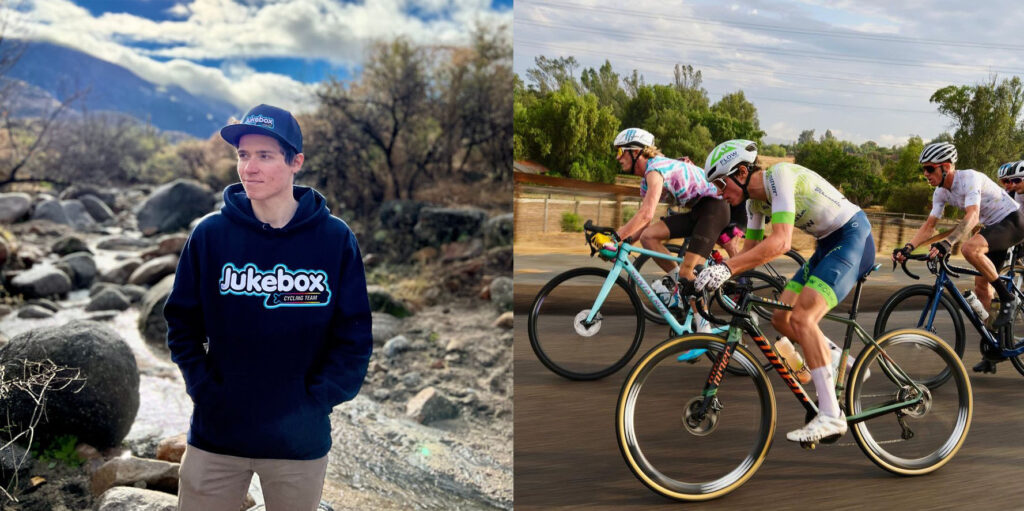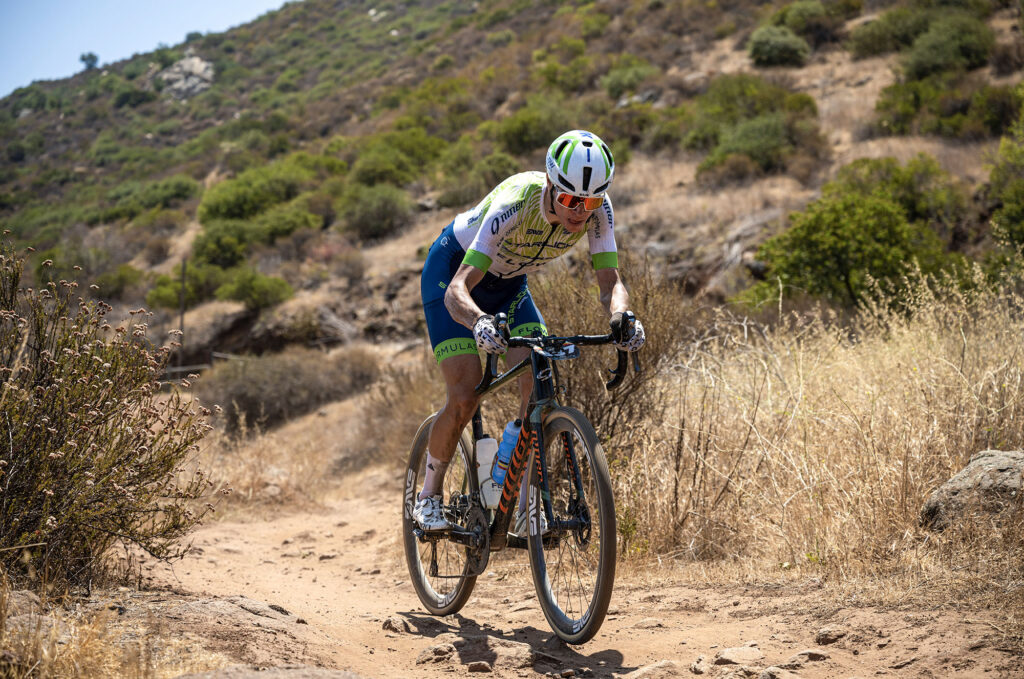Social media marketing is as hot as it’s ever been and more competitive. Much like lining up for a mountain bike or gravel race, Dylan Johnson works to stand out from the content noise online. His approach to the cycling realm of YouTube is to focus on scientific research (while also poking a bit of fun at himself from time to time) and how it relates to performance and training. Through dozens of self-produced videos, Johnson has established a robust audience and leverages those viewers for coaching success.
The following is a Q&A with Johnson about his social media marketing successes and challenges. The conversation has been edited for length and clarity.

TrainingPeaks: Your channel focuses on science-based coaching topics, where you analyze research studies and other information to improve bike racing performance. Why did you choose that angle instead of highlighting workouts or another angle?
Dylan Johnson: The science-based route is of particular interest to me. I try to base most of my decisions and opinions—or at least those that matter—on evidence, specifically what the scientific literature has to say if there is enough of it on said topic. After reviewing the science, I have changed my opinion more times than I count on various training topics. While science is not always perfect, it is more reliable than individual anecdotes or intuition. I can think of numerous training topics where the “correct” answer, or at least the one with the most evidence to support it, is not that intuitive.
TP: What was the initial trigger to set up a YouTube channel? Did you see it as a marketing channel to reach a wider audience from the start?
DJ: I started working for CTS right out of college, and I struggled to have enough athletes to make a comfortable living. Plus, we were highly incentivized to recruit our own athletes as we got paid more when we did, so I started working on marketing myself as a coach. I started first with Instagram with very little success, perhaps it’s the nature of that platform, or maybe I don’t know enough about how to be successful there. I was always a fan of YouTube though, and I saw that while science-based channels existed in other spaces like bodybuilding and fitness or nutrition, it was missing in the cycling space, so that was the niche I decided to fill.
TP: Was YouTube a go-to social media platform for you before starting your channel?
DJ: Yes, it is by far my favorite platform, and in my opinion, it should be yours too. Why? YouTube is one of the only social media sites found to improve users’ mental health. This is probably because instead of constantly trying to impress their peer’s users are actually learning something, or at the very least, they just go there to get entertained. Don’t get me wrong, YouTube can be a massive time suck, just like every social media site. You have to be careful about getting addicted to it, but more often than not, you come away from a YouTube session with some knowledge or perspective that you didn’t have before.
TP: How do other social media platforms fit into your broader online marketing strategy?
DJ: I market myself as a racer (less so my coaching) heavily on Instagram because that is the social media site to do it, and that’s where the industry’s eyes are. YouTube and Instagram both feed each other, and I would add Facebook to that, too, but I stay away from other social media sites like Twitter or TikTok to not completely waste my life online.
TP: In a different discussion we’ve had, you talked about finding a niche or figuring a way to stand out from the noise. You pointed out how you watched and evaluated other fitness and health sectors of YouTube, like bodybuilding, nutrition, etc., and the coaching channels to key on science-based content. What advice do you have for coaches to find their niche on and offline to have a better foundation for rising above the commotion?
DJ: Exactly. Like I said before, this is important because if you copy something that is working for someone else, there are hundreds more trying to copy them too. It’s unlikely that any of these people will be successful, though, because someone is already having success doing that, and they were first, so they are establishing the audience. It can be difficult because it seems like every niche has been filled, but it could be something as simple as a quirky personality, or sense of humor, or a unique perspective that sets you apart. You don’t need to be radically different from what’s already out there, just not an exact copy.
TP: Your videos on YouTube are generally in the 15-20-minute range. How long does it take you to create a video from concept to hitting publish?
DJ: It is probably 15 hours of work, depending on how much research I need to do. The research takes up most of the time, and then there is writing the script, filming and editing.
TP: Did you have to invest a lot into camera gear to put these videos together? And how long did it take you to learn how to edit the pieces together?
DJ: I actually just use my phone, but I do have studio lights and a microphone. I learned a bit about editing in high school, but most of what I know now is from learning as I go. And the editing process has gotten better and better, which means I can do it faster. There is still a lot that I don’t know about editing, though.
TP: Now that you’re growing your personal brand through your YouTube channel, are there any drawbacks to maintaining your online presence through social media?
DJ: The benefits far outweigh any drawbacks in my experience. Getting on YouTube completely changed the course of my professional career. That being said, the biggest drawback is dealing with online criticism, and many people don’t handle it well. You could get 100 positive comments and two or three negative ones, and those negative ones stick with you. It is easy for people who haven’t put themselves out there on the internet to say, “Well, just don’t let that bother you.” It bothers you. I have gotten a lot better about not getting worked up about negative comments, and now they usually don’t get to me.
I was the target of what some might refer to as “cancel culture” this summer. Although, I didn’t lose my job because I employ myself, and my business is doing just fine. So, to say I was “canceled” would be quite a stretch, but I did lose a sponsor. If you go to my channel, it’s probably not hard to tell which video was the catalyst. After my “Do Transgender Athletes Have an Unfair Advantage? The Science” video was published, in which I reviewed the science on whether hormone therapy brings transgender women down to the level of cisgender women athletically, the wave of online criticism was immense. At least compared to what I’m used to on a typical video.
I am all for constructive criticism, but this went far beyond that. I still think about some of the comments that were posted multiple times a day, every day. In an age where we are starting to prioritize mental health, I think this is something that we all need to keep in mind when using the internet.
TP: You offer a wide range of training plans in the TrainingPeaks Marketplace. How does that fit into your broader coaching strategy?
DJ: It’s my most significant source of income, actually. I only coach four people and have coaches working for me, but most of my coaching revenue is from selling TrainingPeaks plans. People watch my videos, and then at the end of the video, I will plug my plans or plug them in a pinned comment with a link. I think it’s important not to seem like you are a salesperson on YouTube, so I wouldn’t plug your product at the beginning of a video or even every video. People are easily turned off when they feel they are watching an “advertisement.”
TP: How does your YouTube channel help you evolve your coaching philosophy and training plans? Do you go through every comment on your videos? Do you look at the sales numbers of your plans to find any lessons?
DJ: I skim the comment section of every video. Reading every comment individually would take a lot of time. This evolves my coaching philosophy in the main way that I am constantly reading research for videos, which informs how I should prescribe training. I look at the training plan sales, and generally, the more views I’m getting on YouTube, the more plans I’m selling. There are no surprises there.
TP: So, that’s enough about all the marketing and video work you do. What are your big goals for yourself and your coaching business going forward?
DJ: I race gravel and mountain bikes professionally, so most of my biggest goals in life are performance-related, and in turn, good performances at races do help my business. I do occasionally document my own racing on my channel. I like to continue to grow the channel as much as possible. I don’t know how big a nerdy, sciency, cycling training channel can get, I’m a bit surprised that over 100k people find this stuff interesting enough to subscribe already, but I want to find out.
TP: Thanks for taking the time to chat with us today, Dylan. Any last words or inspirational quotes we can hang on the office wall?
DJ: Business success can be exponential, so if you are starting out and seeing very slow growth, that does not mean that will be your growth rate forever. That’s how it works on YouTube, but unfortunately, that’s the opposite of how it works in athletics, where there is a diminishing return as you approach your genetic ceiling. That doesn’t mean I won’t give it my all in both endeavors, though.











